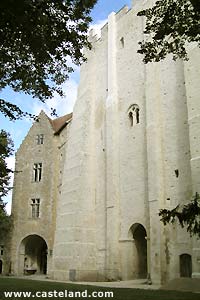

Cher |
Eure & Loir |
Indre |
Indre & Loire |
Loir & Cher |
Loiret |
Other regions & other castles |
Previous months’ selections |
| Castle of Nogent le Rotrou |
|
|
6 - The One hundred Year old war The One hundred Year
old war will replace the Pole in the center of the Franco-English
competition and will give again with the castle of Nogent a defensive
role which it had not played any more for several centuries. The
Pole, asserted like Normandy by the kings of England, had to undergo
on several occasions the fatal attacks of the English. 7 - End XVe at the beginning XVIe century It is to the "young ladies of Armagnac" that one allots the current aspect of the castle: rebuilding of the home above the passage arched in cradle, formant rez of roadway, heightening of the turns of the entry crowned of decorative machicolations. The "steps of Jean Saint" connecting the castle to the district of Pâty go back to this time. 8 - XVIe century The seigniory of Nogent-le-Rotrou
passes to the family of theCop, which frequently remains there.
The castle is the theatre of a sumptuous life: in 1558, one celebrates
the new drafting of the habits of the Large-Pole; in 1566, one celebrates
the birth of Charles of Bourbon, future count de Soissons. The poets
of Pleïade interpret "the Judgement of Pâris".
9 - XVIIe at the XVIIIe centuries 1624 - The duke of
Sully becomes owner of the castle. The project imposing which had
been considered by the minister of Henri IV - to reverse the old
keep of the counts of the Pole to rebuild a traditional residence
of style - were not fortunately I ever realized. The small house
of style Louis XIII is the only vestige of this period. The alley
of elms that Sully made plant on the circumference external of the
enclosure is cut down - two centuries later. 10 - XIXe at the XXe centuries
|
|
Castle of the month : |
Search |
For any question concerning this Web site, send a message to webmaster


 During
these two centuries, the castle passes between several hands. The
9 juin1836, Victor Hugo written to his wife "We saw and visited
in Nogent it Rotrou this castle which one wanted to sell to me,
there are six to seven years. Nanteuil makes of them for you a sketch
of remembering while I write to you. The outside of the castle is
still very beautiful and superbly dominates an immense horizon of
undulating plains. Interior N is that dilapidation ".
During
these two centuries, the castle passes between several hands. The
9 juin1836, Victor Hugo written to his wife "We saw and visited
in Nogent it Rotrou this castle which one wanted to sell to me,
there are six to seven years. Nanteuil makes of them for you a sketch
of remembering while I write to you. The outside of the castle is
still very beautiful and superbly dominates an immense horizon of
undulating plains. Interior N is that dilapidation ". 
